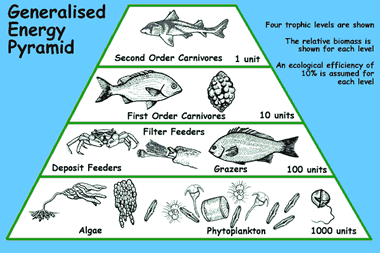|
|
 |
The First Trophic Level consists of marine plants. This is made up of single-celled phytoplankton, algae and some seagrasses. They bring carbon into the food chain by fixating energy from the sun, and release oxygen into the water and atmosphere. The plants are the Primary Producers. Some of the algae of the shore are the green algae, brown algae and red algae. |
The Second Trophic Level are the browsers and grazers of algae, and phytoplankton eaters. Some of these are the Top Shells, such as the Zebra Top Shell, Austrocochlea porcata, Ribbed Top Shell, Austrocochlea constricta, the Common Variegated Limpet, Celana tramoserica and the Black Nerite, Nerita atramentosa. The Luderick, Girella tricuspidata, or Black Fish is an algae feeder and prefers Sea Lettuce, Ulva lactuca.
We also include the Filter Feeders at this level. They eat both photoplankton and zooplankon, which are the small animals and juvenile stages of many marine creatures drifting in the oceans. Filter Feeders strain the plankton from incoming water with their gills, while some also secrete a slime which sticks to the plankton, and cilia take the food to the mouth. Some Filter Feeders are the Serpulid Worm, Galeolaria caespitosa, the Sponges, as well as Bivalves such as the Edible Mussel, Mytilus edulis planulatus, and the Pipi, Donax deltoides.
A third group added to this level are the Deposit Feeders which eat detritus ooze from the ocean floor, as well as the slime which coats rocks and mud shores when the tide has gone out. Mixed up with the detritus are huge volumes of bacteria, breaking it down. The bacteria and detritus are a rich source of nutrients for many specialised animals that eat nothing else. Some of these are the various estuarine shore crabs such as the Semaphore Crab, Heloecius cordiformis and the Mudflat Sentinel Crab, Macropthalmus settosus.
The Third Trophic Level are the First Level Carnivores. They hunt down and eat the herbivores, or is it algavores. They are the predatory molluscs such as the Mulberry Whelk, Morula marginalba, and the Cart-rut Shell, Dicathais orbita and relations. Yellowfin Bream, Acanthopagrus australis, come into the rocky shore at high tide to eat crabs and molluscs. The mollusc and bivalve-eating Sooty Oystercatcher, Haematopus fuliginosus, is a First Level Carnivore.
The Fourth Trophic Level are the Second Level Carnivores. They hunt down and eat both First Level Carnivores and Herbivores. They are usually swift, voracious hunters, because they have to capture a lot of prey to gain the energy they require. Some of these are the Eastern Blue Groper, Achoerodus viridis, and the Port Jackson Shark, Heterodontus portusjacksoni.
References:
Shepherd, S.A. & Thomas, I.M. (1982). Marine Invertebrates of Southern Australia. Pt. 1:. Sth. Aust, Govt. Printer, Adelaide.
Vaughan, H. (1984). The Australian Fisherman's Companion. Lansdown Press.
Nutrient
Absorbers
Grazers & Browsers
Suspension Feeders
Deposit Feeders
Carnivores
Omnivores
Trophic Levels
Energy Pyramid
Home
Page
Taxonomy
Biogeography
Rocky Shores
Tidal Levels
Intertidal Zonation
Environmental Factors
Biological
Factors
Feeding Relationships
Activities
Glossary
References
 Life
on Australian Seashores
Life
on Australian Seashores
by Keith Davey (C) 2000
Learning Consultant
- Media
The University of Newcastle
email at australian_seashores@hotmail.com
Scientific Consultant: Phil
Colman
site created 01.01.98 : updated 01.04.2000
